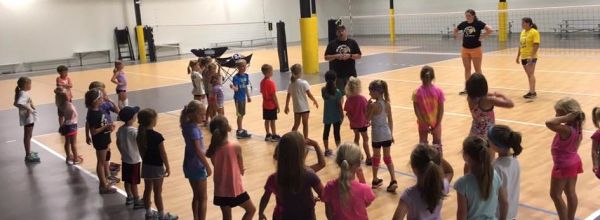Perhaps you have listened to volleyball coaches complain they wish their current players would read the opponent better, or mention disappointment in a player’s current form while performing a specific skill. I’ve heard numerous times a “next level” coach having to “fix” athletes when they get them, lamenting lack of volleyball IQ, lack of transition, or poor form. To this I say:
We didn’t ask them “What color is your dragon” soon enough.
Have you recently watched U5 soccer, with pop up mini nets, no goalies, mini fields, and the joy and smiles of 4 & 5 year olds tickling the twine with a wicked worm killer? USA soccer has done well promoting creativity, motor learning, and functional path training while right sizing the game to their small clients.
I really enjoyed the backward bicycle video. It struck me, how difficult it is to un-teach our brains what we have learned. This video made me ask myself how our younger ages are tackling the conditions we lament when they get older, and how to improve from the current state. One can fix a problem before it begins by solving the root cause.
Having been blessed with the privilege to coach and guide discovery for 20 years at various levels from U12 to U18 club and grade school, I decided that a new challenge was in order. Our club had a kids program in place, K-4th grade, and had wonderful people already committing their time. I volunteered. I learned so much from the roughly 100 annual students, and I realized I had been riding the bicycle backwards for years.
The primary requirements I believe are critical for guiding discovery of these munchkins (ages 3 – 8) after watching many of my wonderful colleagues be successful: Patience, Creativity, and Curiosity
Patience to ask and listen to the kids’ why
Creativity to teach the why in the way the kids learn
Curiosity to learn how to do both of the above better each time with real passion
When I first learned I would have the responsibility of trying to not screw up a child for their future coaches, and I realized the magnitude of being blamed for their bad habits until they were out of college or rec league, I was slightly horrified. Then I read a blog about nursing home volleyball and realized, I could be scarring children for life. I purchased the VolleyTotz video by Texas Advantage’s John Sample from 2011, and thoroughly enjoyed the ideas and passion with which it was presented. I then researched further with USAV’s published information from impact and continue to learn from places like VCT and the Growing the Game resources at USAV. After adding some personal spice to make my own gumbo, as my most recent CAP cadre coach Penny Lucas-White mentioned to us we must do, my own children became the test pilots since I’ve already scarred them as part of their birthright.
Heading into my fourth year of involvement in the Milwaukee Sting Volleybee’s program, I’d like to share some of the concepts and a few of the games the test pilots have enjoyed. I’ve also found these three guiding principles effective when designing programs to teach volleyball for 3 – 9 year olds.
Build from something they already know, be it true or imaginary.
Use visualization with your verbal cues before executing.
Make almost everything a SHORT game or contest.
Example 1
We begin by asking how many 3 – 9 year olds have seen the movie “how to train your dragon” or “how to train your dragon 2”. Most hands raise since 3 – 5 year olds raise their hands automatically when those around them raise their hands. We then ask the player to close their eyes and to picture their own dragon lowering it’s head to allow them to sit on their neck and ride. We ask them to hold the dragon’s ears with their palms up, so the dragon can still hear. We ask them to tighten their knees on the dragons neck by shifting their weight to the balls of their feet to help hold on, but not too tight that they hurt their dragon. We ask them what color their dragon is. My favorite answer from this season was a 4 year old girl who answered in an instant with the specific and passionately delivered, “midnight blue”. We ask if they should be balanced when riding their dragon. Of course you should be low when riding your dragon, “so you can go faster” and the “wind doesn’t throw you backwards off it”. Dragon becomes our verbal cue for ready position, tied to a visualization. Visualization is one of the foremost tools in sports psychology today, and while I’m using a dragon to deliver a lesson, a child is learning another tool they can use to be a better athlete while having fun. 2 minute story and group demo
Example 2
“Dragon Tag” is a warm-up competition, timed and random. I felt utilizing the warm up time in a gym as visualization and reinforcement of the verbal cues was effective use of these 3 minutes, since the magazine Time tells us a goldfish has a longer attention span than a human now. Players choose partners and are asked to spread throughout the gym facing their partner. The dragon riders may only shuffle step to transport themselves, learning to balance while moving quickly. One dragon rider of each pair is selected as “IT”, and that dragon rider must tag the other dragon rider on the knees and yell mine to score a point. For 2 minutes, this continues, and the IT rider chases the not IT rider. After two minutes, reinforcement is given on how to best succeed, remaining low, keeping hands in front, weight on toes, being loud, calling mine, etc. The players switch who is IT, and play a second 2 minute round to determine who wins. Coaches reinforce positive corrections such as remain low, hands in front, tush low during the action, using the established verbal and visualized “dragon”. After time is called, the number of tags are compared in each pair, declaring a winner. The losing group must then roar like an angry dragon as loud as possible. 5 minutes with setup included
Example 3
“Catch a dragon” then expands this concept onto receiving a serve during competition. In a recent camp, while utilizing 4′ high mini nets for the 3 – 7 year olds, a timed grill (game drill) was created by the players throwing first touch balls over the net to each other, followed by the player calling mine then catching the ball in dragon to score a point. We played court versus court, and with the older kids at 7 & 8, we ran the grill as 4 simultaneous competing butterfly drills, having each butterfly group work for the highest number of dragon catches in a specific time frame. The coaches focus their feedback on getting each player to think about where the ball is going to end up and why, and getting there before the ball does. This then easily converts through progression grills (progrills) by adding swings vs tosses, passes vs catches while adding more verbal cues and visualization. Examples of added visualization and verbal cues in the next progrills would be “flamingo” for proper hitting footwork, “alligator” for opening arm and shoulder for preparation to swing, and some of the more traditional moose horns and superman for other concepts. Each of these additional features becomes a game of it’s own. 5 – 7 minutes depending on age and progrill
Example 4
Balloon Mini Volleyball offers coaches the rare opportunity to slow a grill down to its core movements for players while still playing the sport. We chose in our gumbo, to utilize the visualization of a kitchen table for the children to help explain platform. Asking them to visualize what would happen if they dropped a ball on their kitchen table straight down, how it would respond. We then ask them if they bounced it off the table to their parent sitting across from them, why it would not act the same. Their answers are fabulous, ranging from the angle to “my mom won’t let me have volleyballs at the table” all correct answers.
Utilizing a balloon that is round and shaped like a volleyball, allows the concept of a stable platform angled to a target, to be practiced with success. The natural tendency for a first time volleyballer, age 3, age 13, or age 30, is to swing their arms to create velocity. Like unlearning a backward bicycle, I cringe at the future boom ballers this might create. Blow up a balloon, visualize your kitchen table, and pass it to yourself. You will find your platform naturally freezes prior to contact. The flat table translates well in pass self, set self, and hit over net progrill to the other 3 year old who must react on their dragon to get their table flat under the ball, to get their moose horns around it, to get their flamingo to it, to open their alligator jaws, to making their Venus Williams grunt while striking the ball back over the 4′ high obstacle. Each step is added to the progrill, allowing the coach to coach specific portions of the whole, while keeping the chaos minimized but present, for better player success. 5 minute progrills, change teams, score different ways, provide different funsequences, give mvp awards for best sound effects, tabletop of the century, etc
Dragon tag has been a successful and fun warm up game I’ve utilized for my U12 and U14 athletes. It breaks the monotony of a 6 month season, and can often be used to correct bad habits and posture during ready position and improve competition in your practice. Balloon and sitting volleyball is awesome, just ask the nursing home patients who combine both for their daily physical activity. We have all wished our older children kept a stable platform angled to their target, or remained weight on toes, down low in ready position, attempting to read and beat the ball to where it is going.
At my recent CAP clinic, I enjoyed participating in a “Flamingo” drill Tom Shoji one of our CAP cadres enlightened us with. It was designed to help his DIII athletes learn to engage an odd third contact over the net to start a rally and learn to keep the third hit aggressive and in play. I giggled and remembered my mini athletes were in the middle of doing a mini variation of this progrill with balloons, first touches, and volleylites 20 minutes down the road while I took Tom’s module. I had so much fun playing in Tom’s drill, as much fun as I imagine these 3 – 9 year olds would have competing with balloons and first touch’s in an actual game over a net. And once again, the children taught me how to unlearn the bicycle I may have been riding backwards.
I submit that if you are a serious coach interested in solving your own lamenting of older athletes you now coach, you must first be willing to ask, then be willing to listen to their answer why, and finally be open to guiding discovery in creative ways, to find out, “What color is your dragon?
Click here for more information on coaching volleyball. Click here to view drills for beginners.
About the Author
Brad Van Dam is the Board President for Milwaukee Sting VBC , and the former Youth Academy Director.














